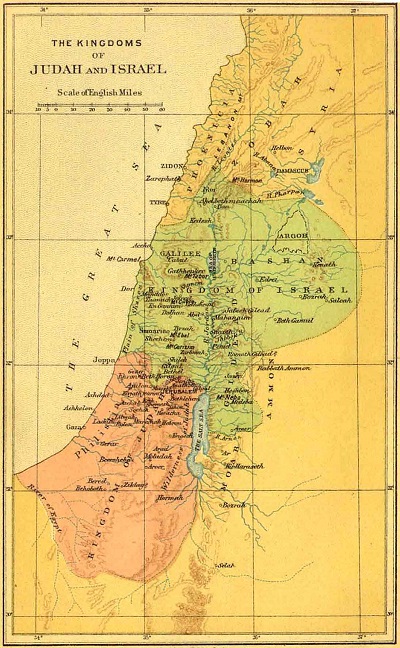Book of DANIEL
Compiled by WD Kemner January 2025
INTRODUCTION
The twelve tribes that had descended from Abraham became a collective nation under first the leadership of Saul and then David. The kingdom saw expansion under Solomon. With the death of Solomon, the twelve tribes split into two separate nations. The nation of Israel was made up of the ten northern tribes and the nation of Judah consisted of the two southern tribes.
Below is a map of the Kingdom of Israel as it looked after the division.
(Map Source: Public Domain)
There were very few righteous kings in either nation. God repeatedly sent prophets to attempt to turn the kings and the two nations back to worship of the true God. Eventually warning each of the nations that God would use other nations in attempt to bring the Jews back to him.
The Assyrians were the world power at that time and were used to punish the tribes. By the end of what has been referred to as the Second Captivity, the northern tribes and their kingdom of Israel no longer existed.
At the point of the first chapter of Daniel, only the nation of Judah exists. It is composed of two tribes and geographically includes the city of Jerusalem. The Babylonians have now taken over domination of the Assyrian empire.
It will be the Babylonians that bring God’s judgment on Judah. It is at this point that the Book of Daniel begins.
Sequence of Kings in Book of Daniel
Throughout the book of Daniel several kings are mentioned. Listed below are the Kings that are mentioned in the book of Daniel. These are the ones that are mentioned by Daniel in his writings. The list is not inclusive of all rulers while in captivity. There were more Kings that are not mentioned by Daniel.
The chapters in the Book of Daniel are not in a chronological sequence by date. The major events are all mentioned first in the book and then the dreams and visions are placed after them so that they are grouped together. This can cause some confusion when the name of a king is mentioned.
KINGS OF BABYLON MENTIONED in BOOK OF DANIEL
They are listed in Chronological Order by the sequence that they reigned in history.
The first two are Babylonian/Chaldean. Darius is a Mede. Cyrus is Persian.
Nebuchadnezzar Chapters 1,2,3,4 Fiery Furnace; King has Dreams
Belshazzar Chapter 7 1st year of Reign Daniel’s 1st Vision: 4 Beasts
Chapter 8 3rd year of Reign Daniel’s 2nd Vision: Ram and Goat
Chapter 5 Last Day of Reign Hand Writing on the Wall
Darius Son of Ahasuerus
Chapter 5:31 Age 62 took Kingdom of Belshazzar
Chapter 9 1st year of Reign Daniel’s 3rd Vision: Weeks of Years
Chapter 6 Date unknown, implied yrs of trust Lion’s Den
Cyrus Chapter 6:28 Listed as successor to Darius
Chapter 10 3rd year of Reign Daniel’s 4th Vision: Israel’s Last Days
(Click on the link for further information on Cyrus)
Summary from the writings of Historian Josephus

Jewish historian Josephus covers the history prior to Daniel’s captivity. Included here are excerpts from his “Complete Works Volume X - Chapters VI–IX.”
These are summarized notes from the words of Josephus and not a direct quotation.
Cast of Jerusalem Kings mentioned by Josephus in the summary include three individuals: Jehoiakim; Jehoiachin the son of Jehoiakim; Zedekiah the half- brother to Jehoiakim
SUMMARY:
Nebuchadnezzar was conquering the area and during 8th year of reign of Jehoiakim required tribute of Jehoiakim. Jehoiakim for 3 years paid tribute. Then did not, expecting to side with Egyptians. That did not work out. Prophet Jeremiah warned him and began his prophecies and writings warning the king. Jehoiakim tried to have Jeremiah imprisoned several times.
Eventually frustration led Babylonian king Nebuchadnezzar to come back in killing many including Jehoiakim. Jehoiakim lived to be 36 and had reigned 11 years. Nebuchadnezzar then placed the son Jehoiachin on the throne and took 3000 captives including the prophet Ezekiel who was then young back to Babylon. Jehoiachin (his mother was Nehushta a citizen of Jerusalem) – he reigned three months and ten days.
Nebuchadnezzar got paranoid and afraid that Jehoiachin would get mad at the killing of his father and bring a revolt. Babylon sent an army back and besieged Jerusalem. This time taking Jehoiachin, his mother and kindred. Babylon took 10,832 captives.
Zedekiah, now age 21 and the uncle to Jehoiachin was made king by Nebuchadnezzar. Zedekiah had the same mother as Jehoiakim. Zedekiah was wicked and despised justice preferring the counsel of young friends. Jeremiah came to him often.
Zedekiah kept his agreement with Babylon eight years before breaking it. Nebuchadnezzar came against the city again and attacked it ending the siege when he ended up giving chase to the Egyptians. Jeremiah the prophet is arrested and tortured by the Jewish rulers.
In the ninth year of Zedekiah rule, Babylon returns on tenth day of tenth month and besieged the city for 18 months. At the same time as the siege, two calamities came on Jerusalem. A famine and pestilence. Jeremiah was proclaiming from prison. An attempt is made to drown Jeremiah in mire. City was taken 9th day of 4th month, 11th year of reign of Zedekiah.
The siege was done by generals only. Nebuchadnezzar had moved to live in Riblah. Zedekiah is captured as his friends deserted him. He is brought before Nebuchadnezzar, his family killed and his eyes blinded before being led to Babylon as foretold by Ezekiel and Jeremiah.
The general of the Babylonian army placed a governor over the people in the country being left behind, the poor and those that deserted. Jeremiah is also released by the Babylonians. Those that deserted would eventually ban together and fight conflicts with their own people before ending up in Egypt. There they are killed and or taken captive when Babylon had to come in to Egypt.
The king of Babylon placed one group from the inner parts of Persia and Media, a nation called the Cutheans in the land of the Jews. This group became known as “Samaritans”. Otherwise the land would remain desolate for the next 70 years.
The entire interval from the captivity of the Israelites to the carrying away of the two tribes proved to be a hundred and thirty years, six months, and ten days.
